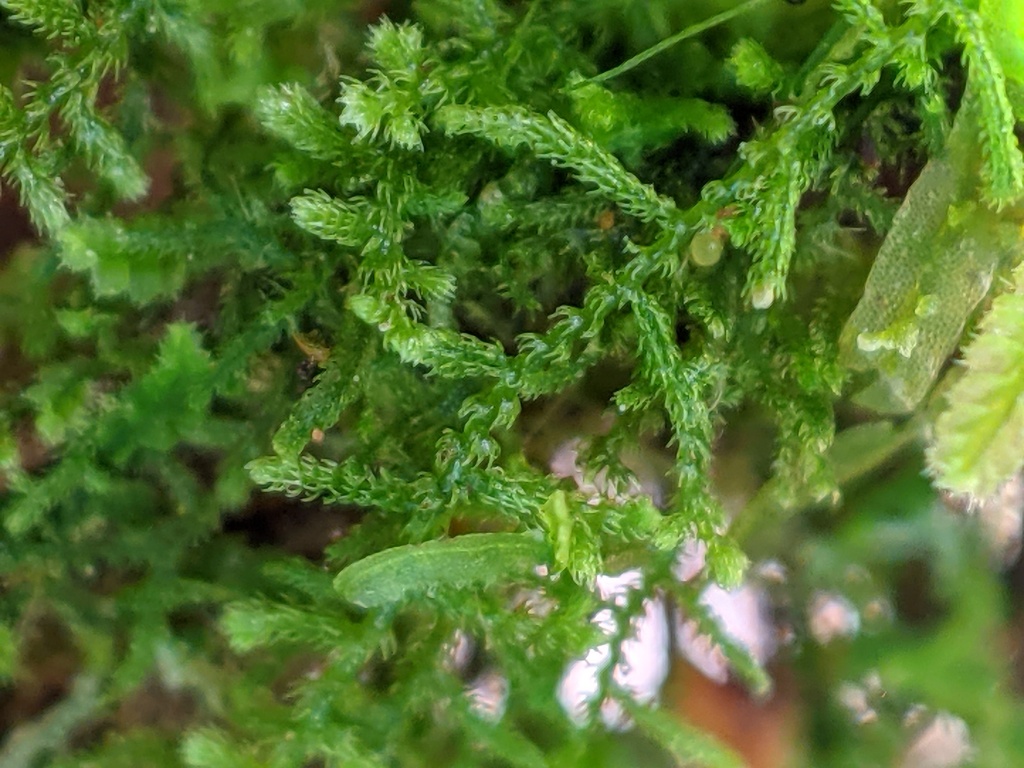Tricholepidozia
Terrestrial, lithophytic or on logs, pale green, yellowish-green, whitish green (not in Victoria), or ferrugineous (not in Victoria), dioicous. Specialised asexual propagules absent. Stems creeping, 1–3-pinnate; branches emerging from stem near abaxial side of lateral leaf with fewer lobes and without a collar of tissue at base, emerging from ventral side of stem and with a collar of tissue at base, or rarely emerging from beside an underleaf with fewer lobes and without a collar of tissue at base (not in Victoria). Lateral leaves obtrapezoidal or rarely rectangular (not in Victoria) in outline, with 2–13 lobes on spreading disc 1–7 cells long or united only by basal cells (not in Victoria), incubous to transversely inserted, alternate, remote (not in Victoria) to imbricate, entire, cuneate or rectangular (not in Victoria) at base; lobes cilia-like, 3–15 cells long, entirely uniseriate or up to 5 cells wide at base and biseriate for up to 3 tiers (not in Victoria). Underleaves similar to lateral leaves and only slightly smaller or much smaller (not in Victoria), with 2–10 cilia-like lobes on disc 1–5 cells long, imbricate to distant (not in Victoria). Leaf cells polygonal, quadrate, oblong, or rectangular, smooth, papillose (not in Victoria) or striolate (not in Victoria), thin- to thick- (not in Victoria) walled, without trigones, with 5–12 oil bodies; oil bodies globose, elliptic, or fusiform, finely granular or coarsely papillose (not in Victoria), hyaline. Rhizoids in fascicles from underleaf disc. Androecia on long (not in Victoria) or short branches, with up to 15 pairs of bracts less dissected than leaves, each with a single antheridium. Sporophytes terminating short branches without vegetative leaves emerging from ventral side of main stem, surrounded by highly differentiated bracts and a perianth; bracts less dissected than vegetative leaves, ovate or elliptic to obovate, 3–5-denticulate or lobulate at apex; perianth cylindric, rarely covered with stiffly spreading cilia (not in Victoria), terete at base, trigonous toward mouth where crenate to denticulate or ciliate (not in Victoria); capsule ellipsoid, 3–5-stratose; elaters bispiral; spores areolate.
Twenty-two species shared between southern South America, Malesia to Vanuatu and New Caledonia, New Zealand and eastern Australia; one species, T. pulcherrima (Steph.) E.D.Cooper, in Victoria.
The species of Tricholepidozia were previously placed in various subgenera of Telaranea by Schuster (2000) are not united by any obvious morphological features, but were shown in phylogenies of DNA regions from nucleus, mitochondrion and chloroplast to form a lineage closely related to Lepidozia, but not to Telaranea (Cooper et al. 2011, 2012).
Cooper, E.D., Shaw, A.J., Shaw, B., Henwood, M.J., Heslewood, M.M. & Brown, E.A. (2011). A multi-locus molecular phylogeny of the Lepidoziaceae: Laying the foundations for a stable classification. Molecular Phylogenetics and Evolution 59: 489–509.
Cooper, E.D., Henwood, M.J. & Brown, E.A. (2012). A molecular phylogeny of the Lepidozia generic complex supports re-circumscription of the Lepidozioideae. Molecular Phylogenetics and Evolution 65: 10–22.
Schuster, R.M. (2000). Austral Hepaticae Part I. Nova Hedwigia Beiheft 118. Cramer in der Gebrüder Borntraeger Verlagsbuchbehandlung: Berling & Stuttgart.
 Spinning
Spinning